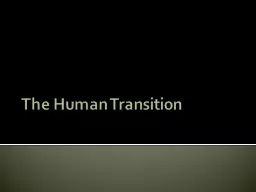PPT-The Human Transition
Author : calandra-battersby | Published Date : 2016-05-21
2 million years ago Bipedal hominids with specialized teeth and expanded brains were walking around East Africa Some made artifacts out of wood stone bone and they
Presentation Embed Code
Download Presentation
Download Presentation The PPT/PDF document "The Human Transition" is the property of its rightful owner. Permission is granted to download and print the materials on this website for personal, non-commercial use only, and to display it on your personal computer provided you do not modify the materials and that you retain all copyright notices contained in the materials. By downloading content from our website, you accept the terms of this agreement.
The Human Transition: Transcript
Download Rules Of Document
"The Human Transition"The content belongs to its owner. You may download and print it for personal use, without modification, and keep all copyright notices. By downloading, you agree to these terms.
Related Documents














